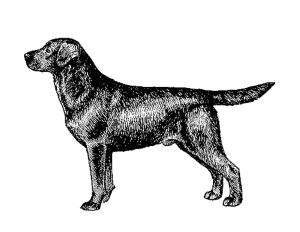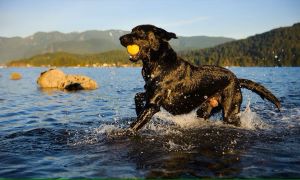The Labrador Retriever is one of the most popular dog breeds in the world and, according to the AKC, the most popular in the United States from 1991 to 2021. Known for their friendly demeanor, intelligence, and versatility, these dogs are eager to please. Originally bred as a working dog, Labradors have excelled in various roles, including hunting, assistance work, and family companionship.
What is the History of Labrador Retrievers?
The history of the Labrador Retriever is closely tied to the coastal region of Newfoundland, Canada. In the early 19th century, the breed's ancestors, known as St. John's water dogs, were developed by fishermen and hunters in the area. These dogs were highly valued for their exceptional retrieving abilities and versatility in assisting with various tasks.
The St. John's water dogs were a mix of indigenous Canadian dogs, working dogs brought by European fishermen, and possibly Portuguese Water Dogs. They were well-adapted to the rugged and challenging environment of Newfoundland, where they were utilized by fishermen to retrieve fish that escaped from nets and to assist in hauling fishing lines through the icy waters.
These early dogs possessed many of the qualities that define the Labrador Retriever today, including a love for water, a gentle mouth for carrying items, and a natural instinct for retrieving. Their ability to work in harsh conditions and their friendly, loyal nature made them highly sought after by both fishermen and hunters in the region.
Exportation to England:
In the early 1800s, English ships visiting Newfoundland encountered these remarkable dogs and were impressed by their skills and temperament. They began to bring the St. John's water dogs back to England, where they quickly gained popularity among British sportsmen.
The breed's name underwent a transformation during this time. They were initially referred to as "St. John's dogs" or "Lesser Newfoundland dogs" in England. Eventually, they became known as Labrador Retrievers, named after the Labrador Sea, which is adjacent to Newfoundland.
Labrador Retrievers find their calling:
In England, breeders worked on refining the characteristics of the Labrador Retriever to suit specific purposes. The breed was primarily developed for retrieving game during hunts, both on land and in water. Their excellent scenting ability, endurance, and gentle mouth made them exceptional at retrieving shot waterfowl, making them valuable companions for hunters.
The breed's reputation continued to grow, and by the early 20th century, Labrador Retrievers had established themselves as one of the most popular sporting breeds in England. Their versatility extended beyond hunting, as they were also employed as service dogs, assisting people with disabilities and working alongside law enforcement agencies.
Recognition and Breed Standard:
In the early 1900s, Labrador Retrievers made their way to North America, where they gained recognition and popularity. The breed was officially recognized by the American Kennel Club (AKC) in 1917, further solidifying its status as a distinguished breed.
Modern Labrador Retrievers:
Today, Labrador Retrievers are beloved worldwide, known not only for their working abilities but also for their gentle and friendly temperament. They excel as family pets, therapy dogs, search and rescue dogs, and various other roles that require intelligence, trainability, and a kind disposition.
The Labrador Retriever's rich history as a versatile working dog with exceptional retrieving skills has made it a cherished breed among dog enthusiasts. Its journey from the shores of Newfoundland to the fields of England and beyond is a testament to its enduring qualities and its ability to forge deep bonds with humans.
Do Labrador Retrievers Have Health Issues?
Labrador Retrievers are generally a healthy breed, but like all dogs, they can be prone to certain health conditions. Responsible breeding practices and regular veterinary care are essential for maintaining their overall well-being. Here are some common health considerations for Labrador Retrievers:
- Hip and Elbow Dysplasia: Labradors may be susceptible to hip and elbow dysplasia, which are developmental conditions affecting the joints. Regular screening and proper breeding practices can help reduce the risk of these conditions.
- Progressive Retinal Atrophy (PRA): PRA is a group of degenerative eye diseases that can lead to vision loss. Genetic testing and regular eye examinations by a veterinarian can help identify and manage PRA in Labradors.
- Exercise-Induced Collapse (EIC): EIC is a condition characterized by episodes of muscle weakness or collapse after intense exercise. It is more common in working lines of Labradors. Responsible breeders often test their breeding stock for the EIC gene to reduce the risk of passing it on to offspring.
- Obesity: Labradors have a hearty appetite and can be prone to weight gain if not fed a balanced diet and provided with regular exercise. Obesity can lead to various health issues, including joint problems, diabetes, and heart disease.
- Ear Infections: Due to their floppy ears and love for the water, Labradors are more susceptible to ear infections. Regular ear cleaning and proper drying after swimming or bathing can help prevent these infections.
Regular veterinary check-ups, a balanced diet, regular exercise, and maintaining a healthy weight are crucial for the overall health and longevity of Labrador Retrievers.
What is the Temperament of Labrador Retrievers?
Labrador Retrievers are well-known for their friendly and outgoing temperament. They are often described as gentle, affectionate, and eager to please. Here are some key characteristics of their temperament:
- Friendly and Sociable: Labradors typically have a friendly and sociable nature, making them excellent family dogs and companions. They usually get along well with children, other dogs, and even strangers.
- Desire to Please: Labradors are intelligent and highly eager to learn. They are quick learners and excel in various training activities, making them suitable for various roles such as service dogs, therapy dogs, and search and rescue work.
- Gentle and Patient: Labradors are generally gentle and patient, which makes them well-suited for households with children. They often exhibit a calm and tolerant nature, even in the face of exuberant play or roughhousing.
- Energetic: Labradors have a good amount of energy and require regular exercise and mental stimulation to prevent boredom. They enjoy activities such as fetching, swimming, and hiking. Providing outlets for their energy is essential for their well-being.
- Retrieving Instinct: As a breed developed for retrieving, Labradors have a natural instinct to carry objects in their mouths. This instinct can make them prone to chewing, so providing appropriate chew toys and training them to redirect this behavior is important.
What is the Best Way to Train Labrador Retrievers?
Labradors are highly trainable dogs due to their intelligence, willingness to please, and strong bond with their owners. Positive reinforcement training methods paired with appropriate corrections work best for Labradors, as they respond well to praise as a reward. Here are some training tips for Labradors:
- Start Early: Begin training your Labrador as soon as you bring them home. Early socialization and basic obedience training are crucial for their development and will help shape their behavior.
- Be Consistent: Consistency is key when training a Labrador. Use clear commands, establish rules and boundaries, and enforce them consistently to avoid confusion.
- Use Positive Reinforcement: Reward-based training methods, such as treats when young and moving to praise work well with Labradors. Balance the positive reinforcement with fair corrections when they do the wrong thing, and they will become a wonderful part of your family. They respond positively to encouragement and will be motivated to repeat behaviors that earn them rewards.
- Incorporate Mental Stimulation: Labradors are intelligent dogs that thrive on mental stimulation. Incorporate puzzle toys, interactive games, and obedience training sessions that challenge their minds and keep them engaged.
- Be Patient and Persistent: Training a Labrador may require patience and persistence, as they can be a bit stubborn at times. Stay positive, keep training sessions short and enjoyable, and celebrate small victories along the way.
How Much Grooming Do Labrador Retrievers Require?
Labrador Retrievers have a short, dense double coat that is relatively easy to maintain. Regular grooming helps keep their coat healthy and minimize shedding. Here are some grooming tips for Labradors:
- Brushing: Labradors benefit from regular brushing to remove loose hair and keep their coat clean. A rubber grooming mitt or a soft bristle brush is usually sufficient for their short coat.
- Bathing: Labradors have a water-resistant coat and do not require frequent bathing. Aim for bathing them every few months or when they get excessively dirty. Use a dog-specific shampoo to avoid skin irritation.
- Nail Trimming: Regular nail trimming is important to prevent overgrowth and discomfort. If you hear their nails clicking on the floor, it's a sign that they need a trim. Use proper dog nail clippers or seek professional help if you're not comfortable doing it yourself.
- Dental Care: Good dental hygiene is crucial for Labradors. Hard chews like Deer or Elk Antlers and synthetic ones like Duralast Nylabones or Benebones will help prevent tatar buildup. Brush their teeth regularly with a dog-specific toothbrush and toothpaste to prevent dental issues and bad breath.
How Much Exercise Do Labrador Retrievers Need?
Labrador Retrievers are an active breed and require regular exercise to keep them physically and mentally stimulated. Here are some exercise considerations for Labradors:
- Daily Walks: Aim for at least one to two daily walks of moderate length to meet their exercise needs. Walking not only provides physical exercise but heeling a dog also helps with mental stimulation and socialization.
- Playtime and Retrieving Games: Labradors have a strong retrieving instinct, and games such as fetch can be an excellent way to exercise them. Use a ball or a retrieving toy to engage them in playful activities.
- Swimming: Many Labradors are natural swimmers and thoroughly enjoy water activities. Swimming is a low-impact exercise that is great for their joints and provides a full-body workout.
- Mental Stimulation: In addition to physical exercise, Labradors benefit from mental stimulation activities such as puzzle toys, scent work, obedience training, and interactive games. Engage their minds to prevent boredom and destructive behaviors.
Do Labrador Retrievers Need Special Nutrition?
Proper nutrition is essential for the health and well-being of Labrador Retrievers. Feeding them a balanced diet that meets their nutritional requirements is important to support their energy levels, maintain a healthy weight, and promote overall health. Here are some nutrition tips for Labradors:
- High-Quality Dog Food: Choose a high-quality dog food that is specifically formulated for medium to large-sized breeds. Look for a balanced diet that includes quality protein sources, healthy fats, and essential vitamins and minerals.
- Portion Control: Labradors have a tendency to overeat, which can lead to obesity. Follow portion guidelines provided by the food manufacturer and adjust based on your Labrador's activity level, age, and overall condition.
- Treats and Rewards: It's fine to give your dogs treats, but be mindful of the calorie content. Opt for healthy, low-calorie treats or use a portion of their regular food as a reward.
- Avoid Table Scraps: Human food, especially certain ingredients like chocolate, onions, and grapes, can be toxic to dogs. Avoid feeding table scraps or unhealthy snacks to prevent digestive issues and potential health risks.
- Fresh Water: Ensure your Labrador has access to fresh, clean water at all times. Hydration is crucial for their overall health and well-being.
Consult with your veterinarian to determine the appropriate diet, feeding schedule, and portion sizes for your Labrador Retriever, taking into account their age, activity level, and any specific dietary needs.
Conclusion
In conclusion, Labrador Retrievers are beloved companions and versatile working dogs with a rich history and exceptional qualities. Their friendly temperament, intelligence, trainability, and adaptability make them a popular choice for individuals and families. By providing them with proper health care, training, grooming, exercise, and nutrition, you can ensure that your Labrador Retriever thrives and enjoys a happy and fulfilling life as a cherished member of your household.
The article above contains Affiliate Links from Amazon and other companies. If you visit their site and buy the product, we will get a small commission. Please know that we only recommend products we truly love and would never recommend a product we don't think is incredible. We look at and try hundreds of products before we ever recommend them to our clients!













